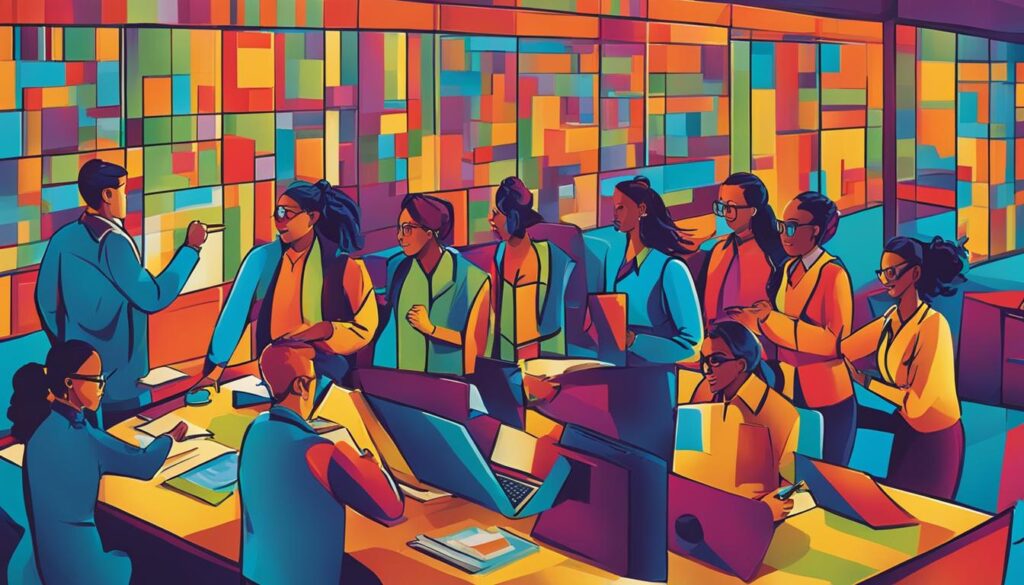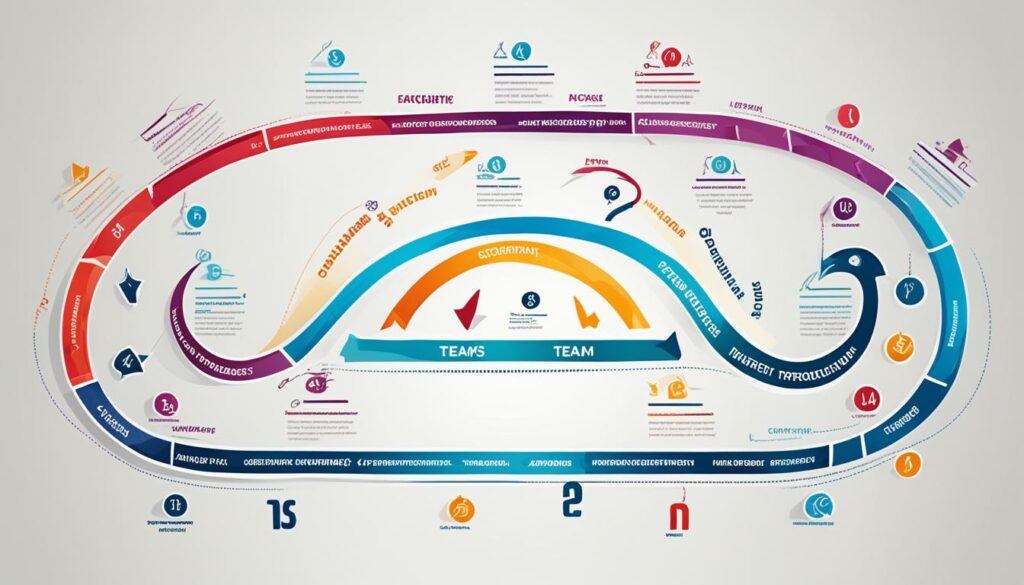Imagine this scenario: a group of individuals, each with their unique skills and backgrounds, comes together to form a team in a workplace. They bring their diverse experiences, expertise, and perspectives to the table, ready to tackle projects and achieve objectives. However, as they start working together, they realize that effective collaboration and communication are easier said than done. They encounter misunderstandings, clashes of opinion, and struggle to find their rhythm as a team. This is where team dynamics forming becomes crucial.
Team dynamics forming refers to the process of establishing effective teamwork and cohesive relationships within a group. It allows individuals to understand each other’s strengths, weaknesses, and working styles, leading to improved collaboration and synergy. By recognizing and addressing the dynamics at play, teams can build a solid foundation for success.
In this article, we will delve into the intricacies of team dynamics forming in workplaces. We will explore the stages of team development, the impact of individual temperament and group dynamics, and strategies for fostering effective communication and team cohesion. Whether you are a leader looking to enhance team performance or a team member seeking a better understanding of team dynamics, this article will provide valuable insights and practical tips to navigate the complexities of working in a team. As organizations continue to evolve, understanding the nuances of team dynamics in the workplace has become increasingly critical for success. By examining how diverse personalities and different working styles interact, we can identify common barriers to collaboration and find ways to overcome them. Ultimately, harnessing positive team dynamics can lead to improved productivity, innovation, and job satisfaction for all team members.
Key Takeaways:
- Team dynamics forming is crucial for effective collaboration and communication within a team.
- Understanding the stages of team development and the impact of individual and group dynamics is essential.
- Effective communication plays a critical role in fostering team cohesion.
- Leadership is instrumental in guiding teams through the various stages of development.
- By utilizing team building strategies and promoting effective team communication, organizations can create high-performing teams.
The Benefits of Positive Team Dynamics
Positive team dynamics play a pivotal role in the success and growth of organizations. They foster collaboration, improve communication, boost morale, and enhance overall team performance. By promoting teamwork effectiveness and creating a culture of synergy and cohesion, organizations can achieve their strategic objectives and drive sustainable growth.
There are several benefits of positive team dynamics:
- Enhanced Collaboration: When team members work together cohesively, they can leverage their diverse skills, knowledge, and perspectives to solve complex problems and achieve common goals. Collaboration within a team promotes creativity, innovation, and efficiency.
- Improved Communication: Effective communication is vital for team success. Positive team dynamics encourage open and transparent communication, ensuring that team members understand their roles, responsibilities, and expectations. Clear communication channels facilitate the exchange of ideas, feedback, and information, leading to better decision-making and problem-solving.
- Boosted Morale and Motivation: A team with positive dynamics fosters a supportive and inclusive environment where team members feel valued, recognized, and motivated. When individuals feel a sense of belonging and purpose, their morale and motivation increase, leading to higher engagement and productivity.
- Facilitated Effective Conflict Resolution: Conflict is inevitable in any team, but positive team dynamics provide the foundation for resolving conflicts constructively. Team members learn to embrace differences and manage conflicts through open dialogue, active listening, and collaboration. Effective conflict resolution strengthens relationships, encourages compromise, and facilitates personal and professional growth.
- Increased Accountability: Positive team dynamics promote a culture of accountability where team members take ownership of their actions and outcomes. When everyone feels responsible for their contributions, it fosters a high level of commitment and ensures that tasks are completed on time and to the best of each member’s abilities.
- Contribution to Professional Development: Within a team, individuals have the opportunity to learn from one another, share expertise, and develop new skills. Positive team dynamics create a supportive learning environment where team members can grow personally and professionally, expanding their knowledge and capabilities.
- Fostered Cultural Understanding: In today’s diverse workplaces, positive team dynamics contribute to cultural understanding and inclusivity. When team members respect and appreciate one another’s backgrounds, perspectives, and experiences, it paves the way for stronger collaboration and a harmonious work environment.
- Promotion of Resilience to Change: Change is inevitable in the business world. Positive team dynamics cultivate resilience and adaptability among team members, enabling them to navigate and embrace change more effectively. A team with strong dynamics can embrace new challenges, pivot strategies, and thrive in uncertain and dynamic environments.
- Creation of a High-Performance Culture: By nurturing positive team dynamics, organizations create a high-performance culture where individuals are motivated, engaged, and committed to achieving excellence. This culture attracts top talent, retains valuable employees, and sets the stage for sustainable success and growth.
To illustrate the impact of positive team dynamics, consider the following example:
“The collaborative orchestra” is a prime example of successful team dynamics. Just like a symphony orchestra, where diverse instrumentalists come together under the guidance of a conductor to create beautiful music, a team with positive dynamics harnesses individual strengths and synchronizes efforts to achieve extraordinary results. Each team member’s expertise and contribution blend harmoniously, creating a synergy that propels the team to success.
| Benefits of Positive Team Dynamics | Description |
|---|---|
| Enhanced Collaboration | Collaboration leads to creativity, innovation, and efficiency. |
| Improved Communication | Clear communication channels facilitate better decision-making and problem-solving. |
| Boosted Morale and Motivation | A supportive environment increases morale and motivation. |
| Facilitated Effective Conflict Resolution | Constructive conflict resolution strengthens relationships and promotes personal growth. |
| Increased Accountability | A culture of accountability ensures tasks are completed on time and to the best of each member’s abilities. |
| Contribution to Professional Development | Team members learn from one another and develop new skills. |
| Fostered Cultural Understanding | Cultural understanding leads to stronger collaboration and a harmonious work environment. |
| Promotion of Resilience to Change | Positive dynamics enable teams to navigate and embrace change effectively. |
| Creation of a High-Performance Culture | A high-performance culture attracts top talent and drives sustainable success. |
The Essence of Team Dynamics in the Workplace
Team dynamics in the workplace are the cornerstone of effective collaboration and productivity. It encompasses the interactions, relationships, and behaviors among individuals within a team. Fostering team cohesion and understanding group dynamics is crucial for creating a harmonious and high-performing team environment. Effective communication, trust, and mutual respect are essential components that contribute to positive team dynamics in the workplace. Leaders play a pivotal role in cultivating an atmosphere where team members feel valued and empowered to share their ideas. By investing time in team-building activities and conflict resolution strategies, organizations can enhance team dynamics in the workplace, ultimately leading to increased innovation and success.
In the realm of team dynamics, there are both formal and informal aspects that shape the dynamics within a team. The formal aspects include roles and structure, outlining the specific responsibilities and hierarchy within the team. On the other hand, the informal aspects encompass interpersonal relationships, communication styles, and the overall team culture.
Communication patterns play a significant role in team dynamics. Effective and open communication channels ensure that information flows smoothly among team members, minimizing misunderstandings and fostering collaboration. Moreover, power structures within a team can influence decision-making processes and the distribution of authority, impacting team dynamics. Understanding and managing these power dynamics can contribute to a more inclusive and cohesive team environment.
Roles and responsibilities are another important component of team dynamics. When team members have clear roles and understand their individual contributions, it promotes efficiency and reduces conflicts. Additionally, conflict resolution strategies are essential for managing disagreements that may arise within the team. Addressing conflicts promptly and constructively helps to maintain trust and harmony among team members.
Building trust and psychological safety within the team is vital for fostering team cohesion. Trust allows team members to feel safe sharing ideas, taking risks, and being vulnerable, which ultimately leads to increased collaboration and innovation. Psychological safety refers to an environment where individuals feel comfortable expressing themselves without fear of negative consequences. It enables open and honest communication, which strengthens team dynamics.
“Teamwork is the ability to work together toward a common vision. The ability to direct individual accomplishments towards organizational objectives. It is the fuel that allows common people to attain uncommon results.” – Andrew Carnegie
Fostering Team Cohesion
Building team cohesion is a fundamental aspect of fostering positive team dynamics. Here are some strategies to enhance team cohesion:
- Promote open and transparent communication to ensure everyone’s voices are heard and valued.
- Establish clear goals and objectives that align with the team’s purpose, ensuring everyone is working towards a common vision.
- Create opportunities for team building activities and social interactions to strengthen interpersonal relationships.
- Encourage collaboration and knowledge sharing to leverage the diverse skills and expertise within the team.
- Foster a culture of psychological safety, where mistakes are viewed as learning opportunities and innovation is encouraged.
Fostering team cohesion requires consistent effort and a holistic approach that addresses both the formal and informal aspects of team dynamics. By prioritizing open communication, trust-building, and shared goals, organizations can create an environment that fosters synergy, creativity, and high performance.
| Fostering Team Cohesion | Benefits |
|---|---|
| Open and transparent communication | – Encourages collaboration and idea-sharing – Builds trust and psychological safety |
| Clear goals and objectives | – Aligns team members towards a common vision – Promotes clarity and accountability |
| Team building activities and social interactions | – Strengthens interpersonal relationships – Improves teamwork and cooperation |
| Collaboration and knowledge sharing | – Leverages diverse skills and expertise – Enhances problem-solving capabilities |
| Culture of psychological safety | – Encourages innovation and creativity – Enables open and honest communication |

Examples of Successful Team Dynamics
Successful team dynamics are reflected in various scenarios where individuals come together to create a cohesive and high-performing team. These examples showcase the importance of effective team communication and the different stages of team development.
The Collaborative Orchestra
The collaborative orchestra represents a team where diverse skills and perspectives are harmonized for innovation. Each member brings their unique expertise to the table, contributing to a unified and creative approach. By leveraging effective team communication, the collaborative orchestra produces harmonious results that surpass individual capabilities.
The Constructive Challenger
The constructive challenger is a team member who encourages critical thinking and alternative solutions. By challenging the status quo and fostering a culture of innovation, they inject fresh ideas and perspectives into the team. This dynamic allows for continuous improvement and growth, leading to successful outcomes.
The Synergy Spark
The synergy spark represents team members who inspire and motivate one another through their actions and positive mindset. They establish a supportive and uplifting environment, fostering a sense of camaraderie and unity. This sparks creativity, productivity, and a shared commitment to achieving team goals.
The Mentorship Nexus
In the mentorship nexus, experienced team members take on the role of mentors to guide and mentor junior colleagues. This dynamic allows for knowledge transfer, skill-building, and personal growth within the team. By fostering a culture of continuous learning, the mentorship nexus contributes to the overall development and success of the team.
The Inclusion Initiator
The inclusion initiator ensures that everyone’s voices are heard and valued within the team. They promote a sense of belonging and psychological safety, creating an inclusive environment where diverse perspectives are appreciated. By actively encouraging and embracing different viewpoints, the inclusion initiator enhances collaboration and team effectiveness.

These examples illustrate how individual behavior and contributions shape overall team performance and cohesion. By fostering effective team communication and recognizing the various team development stages, organizations can build successful teams that drive productivity, innovation, and success.
Conclusion
Team dynamics forming is pivotal for achieving workplace success. By understanding the various stages of team development, the impact of individual temperament, and group dynamics, organizations can foster cohesion and synergy to build successful teams. Effective team communication plays a crucial role in promoting teamwork effectiveness and enhancing overall productivity.
Utilizing team building strategies is essential for unlocking the full potential of teams. By implementing activities that encourage collaboration, trust-building, and shared goals, organizations can create an environment that fosters innovation and success. Additionally, promoting open and transparent communication channels enables team members to exchange ideas, resolve conflicts, and streamline decision-making processes.
Investing in team development and cultivating positive team dynamics can yield numerous benefits for organizations. Strong team synergy leads to improved collaboration, increased accountability, and enhanced morale and motivation among team members. Moreover, cohesive teams are better equipped to navigate challenges and adapt to changes in the workplace, driving sustainable growth and attracting top talent.
FAQ
What is team dynamics forming?
Team dynamics forming refers to the process of creating and developing a team in the workplace. It involves understanding the various stages of team development and the impact of individual temperament and group dynamics.
What are some team building strategies?
Some team building strategies include fostering effective communication, promoting collaboration and trust, encouraging diversity and inclusion, providing opportunities for professional development, and creating a positive and supportive work environment.
How does effective team communication contribute to team dynamics?
Effective team communication is a critical component of team dynamics as it helps to foster understanding, collaboration, and cohesion within the team. It allows team members to share information, exchange ideas, resolve conflicts, and work together towards achieving common goals.
What is the role of leadership in team formation?
Leadership plays a crucial role in team formation as it sets the tone, establishes clear goals and expectations, provides guidance and support, and promotes accountability and teamwork. Effective leadership helps to create a positive team culture and facilitates the development of strong team dynamics.
How do team development stages impact team dynamics?
Team development stages, such as forming, storming, norming, and performing, impact team dynamics by influencing the level of trust, communication patterns, power dynamics, and conflict resolution strategies within the team. Understanding these stages can help leaders and team members navigate challenges and foster a cohesive and high-performing team.
How can team cohesion be fostered?
Team cohesion can be fostered through various strategies, including promoting open communication and trust, encouraging collaboration and mutual support, providing opportunities for team bonding and social interaction, recognizing and valuing individual contributions, and maintaining a positive and inclusive team environment.
What are group dynamics in teams?
Group dynamics in teams refer to the interactions, relationships, and behaviors among individuals within a team. It encompasses elements such as communication patterns, power structures, roles and responsibilities, conflict resolution strategies, and the level of trust and psychological safety within the team.
How can team synergy be created?
Team synergy can be created by leveraging the diverse skills, knowledge, and perspectives of team members, fostering open and inclusive communication, encouraging collaboration and creativity, valuing and respecting individual contributions, and promoting a shared sense of purpose and accountability.
How can successful teams be built?
Building successful teams involves promoting effective team communication, fostering teamwork effectiveness, providing opportunities for professional development, encouraging collaboration and trust, and creating a positive and supportive work environment that values diversity and inclusion.
How does teamwork effectiveness contribute to organizational success?
Teamwork effectiveness contributes to organizational success by facilitating collaboration, enhancing communication, increasing productivity and innovation, promoting effective problem-solving and decision-making, and creating a positive and engaging work environment that attracts and retains top talent.


